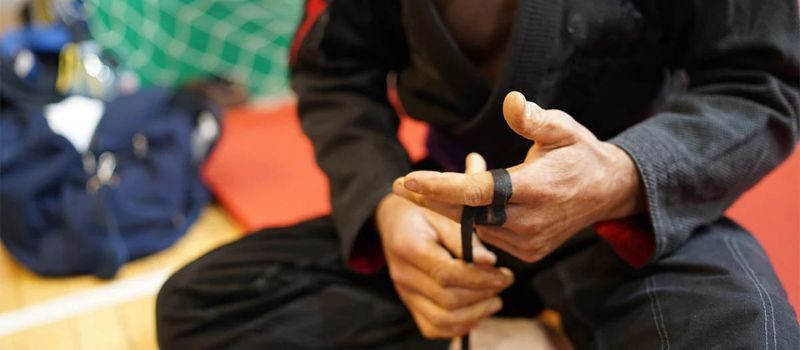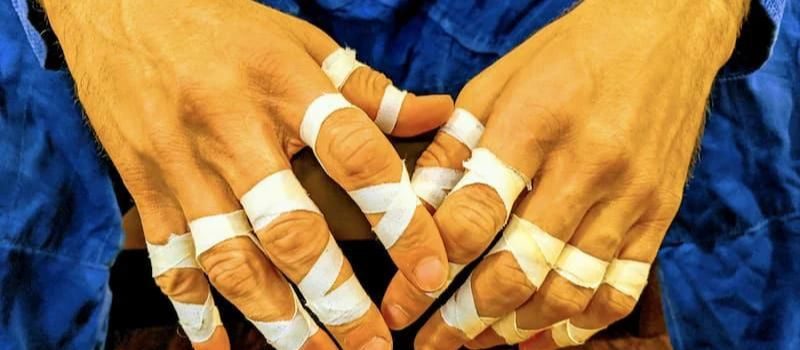The importance of finger taping in Jiu Jitsu
Jiu Jitsu is a physically demanding martial art that requires strength, agility, and flexibility. One area of the body that is particularly susceptible to injury during training and competition is the fingers..Finger taping is an essential practice in Jiu Jitsu that provides support, stability, and protection to the fingers, helping to prevent injuries and maintain optimal performance. In this article, we will explore the importance of this in Jiu Jitsu and provide techniques and tips for effective taping.
Benefits of finger taping in Jiu Jitsu
It offers several benefits for Jiu Jitsu practitioners. Firstly, it provides stability to the fingers, reducing the risk of hyperextension or sprains when executing techniques such as joint locks or grips. It also helps to prevent finger fractures and dislocations by providing an additional layer of support to the bones and ligaments. Moreover, it can improve proprioception, which is the body’s ability to sense its position in space. This enhanced proprioception can assist in maintaining a strong grip and executing precise movements during Jiu Jitsu training and competitions.
Another significant benefit of this is the prevention of skin abrasions and blisters. The repetitive gripping and friction involved in Jiu Jitsu training can cause painful blisters and calluses on the fingers. By applying finger tape, you create a protective barrier that reduces friction and minimizes the risk of developing these uncomfortable and potentially debilitating skin conditions.
Common finger injuries
Finger injuries are a common occurrence in Jiu Jitsu, and they can range from minor sprains to more severe fractures or dislocations. Some of the most frequent finger injuries include jammed fingers, mallet finger, and trigger finger.
A jammed finger occurs when the finger is forcefully bent, causing damage to the ligaments and joint. This injury can result in pain, swelling, and limited range of motion. Mallet finger, on the other hand, is a condition where the extensor tendon is damaged, leading to a drooping or bent fingertip. Lastly, trigger finger is a condition where the finger gets locked in a bent position and then suddenly snaps straight.
Proper technique
To effectively tape your fingers for Jiu Jitsu, it is essential to follow the proper technique. Here is a step-by-step guide:
- Start by cleaning your fingers with soap and water to remove any dirt or oils that could affect the adhesion of the tape.
- Take a strip of finger tape and tear off the desired length. The tape should be long enough to wrap around the base of your finger and cover the joint.
- Place the tape horizontally across the back of your finger, just below the knuckle.
- Wrap the tape around the base of your finger, overlapping each layer by about half of the tape’s width. Make sure to apply firm pressure to ensure the tape adheres properly.
- Continue wrapping the tape around the joint, creating a figure-eight pattern. This pattern provides additional support and stability to the joint.
- Once you have wrapped the joint, secure the end of the tape by pressing it firmly against the skin.

Types of finger tape for Jiu Jitsu
There are various types of finger tape available for Jiu Jitsu practitioners, each with its unique characteristics. Two popular options are athletic tape and adhesive finger tape.
Athletic tape is a versatile option that provides excellent support and flexibility. It is often used by athletes in various sports, including Jiu Jitsu. Athletic tape is available in different widths and materials, allowing for customization based on individual preferences.
Adhesive finger tape, on the other hand, is specifically designed for finger taping. It typically comes in pre-cut strips, making it convenient and easy to apply. Adhesive finger tape offers excellent adhesion and durability, ensuring that it stays in place during intense training sessions.
Tips for applying
- Start with clean:
Dry fingers: Before applying the tape, make sure your fingers are clean and dry to ensure optimal adhesion. - Don’t wrap too tightly: While it is essential to create a secure wrap, avoid wrapping the tape too tightly, as it can restrict blood flow and cause discomfort.
- Leave the fingertips exposed: It is advisable to leave the fingertips exposed when taping your fingers. This allows for better grip and tactile sensitivity during training and competitions.
- Practice proper technique: Take the time to learn the proper finger taping technique and practice it regularly. This will help you become more proficient and efficient in applying the tape.

Finger taping techniques for specific Jiu Jitsu moves
Different Jiu Jitsu techniques may require specific finger taping techniques to provide optimal support and stability. Here are a few examples:
- Grips and joint locks:
When executing grips and joint locks, it is essential to tape the fingers in a figure-eight pattern. This pattern provides added stability to the joints and helps prevent hyperextension or sprains. - Spider guard:
The spider guard is a popular Jiu Jitsu technique that involves gripping your opponent’s sleeves with both hands. To support your gripping fingers, tape them individually, focusing on the joints and knuckles. - Kimura lock:
The Kimura lock targets the shoulder joint, but it requires a strong grip on your opponent’s wrist. To enhance your grip strength and stability, tape your fingers in a figure-eight pattern, paying extra attention to the thumb and index finger.
- Grips and joint locks:
Finger taping techniques for football players
In addition to Jiu Jitsu, it is also crucial for football players. Football involves a significant amount of hand contact, making the fingers vulnerable to injuries. Here are some important techniques specifically for football players:
. Blocking and tackling:
When engaging in blocking or tackling, football players should tape their fingers in a figure-eight pattern to provide stability and prevent injuries.
. Wide receiver:
Wide receivers often need to make catches while maintaining control of the ball. Taping the fingers individually can offer added support and prevent finger sprains or dislocations during these high-impact plays.
Finger taping services and products for Jiu Jitsu and football
If you are new to finger taping or prefer professional assistance, there are services available that specialize in taping for Jiu Jitsu and football. These services can provide personalized taping techniques and advice based on your specific needs and requirements.
There are also numerous products related to this available in the market. From adhesive finger tape to finger sleeves, these products offer various levels of support, flexibility, and durability. It is essential to choose a product that suits your preferences and provides the necessary protection and stability for your fingers.
Conclusion
Finger taping is a vital practice in Jiu Jitsu and football that helps prevent injuries, enhance performance, and provide support and stability to the fingers. By following proper taping techniques and utilizing the right finger tape or products, you can reduce the risk of finger injuries and maintain optimal functionality during training and competitions. Remember to clean your fingers before applying the tape, avoid wrapping too tightly, and practice the correct taping technique regularly. Whether you are a Jiu Jitsu practitioner or a football player, it should be an essential part of your training and preparation routine.
CTA: Protect your fingers and enhance your performance in Jiu Jitsu or football with proper finger taping techniques and quality finger tape products. Start incorporating this into your training routine today for a safer and more effective experience.
FAQ's
1 . Should you tape your fingers in BJJ?
Taping your fingers in BJJ can offer added support and protection, especially if you have existing injuries or want to prevent them. It’s a personal preference, but many practitioners find it helpful.
2 . How do you tape your ring finger in BJJ?
To tape your ring finger in BJJ, start by wrapping a strip of athletic tape around the base of your finger a couple of times. Then, wrap the tape diagonally across the back of your finger, making sure to cover any areas prone to injury. Finish by securing the end of the tape with a final wrap around the base.
3 . What is the point of finger taping?
The primary purpose of finger taping in BJJ is to provide support and stability to the fingers and joints, reducing the risk of sprains, strains, and other injuries. It can also help maintain proper alignment and grip strength during training and competition.
4 . What are the benefits of taping fingers together?
Taping fingers together in BJJ can help distribute pressure more evenly across the hand, reducing the strain on individual fingers. It can also promote better hand positioning and grip technique, enhancing overall performance and preventing overextension of the fingers.
Feel free to comment down there,what you think about this blog


